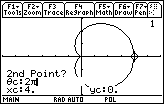Curves described using polar coordinates can be very interesting and the equations are often much simpler in polar form than they are in rectangular form. This lesson explores graphing polar equations.
When graphing polar functions on the TI-89,
![]() is the independent variable and r is the dependent variable. Angles are positive if measured in the counterclockwise direction from the positive x-axis. The independent variable in Polar Graph mode is
is the independent variable and r is the dependent variable. Angles are positive if measured in the counterclockwise direction from the positive x-axis. The independent variable in Polar Graph mode is
![]() .
.
|
|||
|
|
|||
Graphing in Polar Mode
Change to Polar graphing mode on your TI-89.
- Open the Graph Mode menu then highlight "3:POLAR"

-
Select and save this mode by pressing
 twice
twice
Graph the polar function r = 3 sin(2
![]() ).
).
-
Open the Y=Editor by pressing


-
Set r1 = 3sin(2
 )
)
![]() is the green feature above
is the green feature above
![]() .
.

- Enter the following window values
|
|
xmin = –6 | ymin = –3 |
|
|
xmax = 6 | ymax = 3 |
|
|
xscl = 1 | yscl = 1 |
- Display the graph

This graph is called a four-leafed rose.
25.2.1 Predict the shape of the graph of r = 3sin(3
![]() ) then verify your prediction by displaying the graph on your TI-89. Click here to check your answer.
) then verify your prediction by displaying the graph on your TI-89. Click here to check your answer.
Finding the Number of Leaves
There is a relationship between the value of n in the polar function r = 3sin(n
![]() ) and the number of leaves.
) and the number of leaves.
25.2.2 Determine how n relates to the number of leaves in the graph of r = 3sin(n
![]() ) by graphing the following polar functions. You will need to adjust
) by graphing the following polar functions. You will need to adjust
![]() to 2
to 2
![]() for the functions where n is even. You may also want to make
for the functions where n is even. You may also want to make
![]() smaller for the last few functions in order to make the graphs smooth.
smaller for the last few functions in order to make the graphs smooth.
r = 3sin(4
![]() )
)
r = 3sin(5
![]() )
)
r = 3sin(6
![]() )
)
r = 3sin(7
![]() )
)
Click here for the answer.
25.2.3 How many leaves would you expect in the graph of
![]() ? Let
? Let
![]() and graph the function to verify your prediction. Click here for the answer.
and graph the function to verify your prediction. Click here for the answer.
Graphing a Cardioid
Graph the cardioid r = 2(1 + cos
![]() ) using the following viewing window.
) using the following viewing window.


Finding a Tangent Line
Use the Tangent feature to find the equation of the line tangent to the cardioid
![]() at
at
![]()
-
Open the Graph Math menu by pressing

- Highlight "A:Tangent"

-
Select this feature by pressing

-
Enter
 /4 for the prompt "Tangent at?"
/4 for the prompt "Tangent at?"

-
Press


The equation of the tangent line at
![]() is approximately y = -0.414x + 3.414, which is given in xy-coordinates and shown at the bottom of the screen.
is approximately y = -0.414x + 3.414, which is given in xy-coordinates and shown at the bottom of the screen.
Finding Arc Length
Find the arc length of the cardioid r = 2(1 + cos
![]() ) for
) for
![]() .
.
-
Regraph the cardioid by pressing

-
Open the Graph Math menu by pressing

- Highlight "B:Arc"

-
Press

- Enter 0 for the first point

-
Enter 2
 for the second point
for the second point

-
Press


The arc length over the interval
![]() is 16 units.
is 16 units.